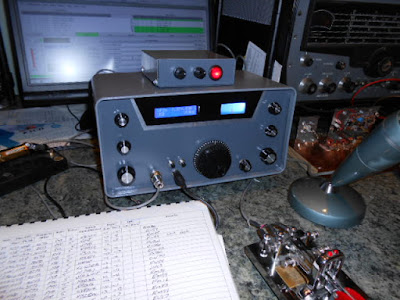Pete, N6QW, has recently posted an excellent blog entry where he talks about (what else?) building stuff and the importance of starting small and progressing to more complex designs as one builds skill and confidence. The Michigan Mighty Mite, a single transistor CW transmitter, is an excellent place to start: It uses a minimal number of parts and is easy to duplicate; if one follows directions, it's almost hard to NOT make it work. But, once you build one, where do you go next? There's a quantum leap between a MMM and something like a BiTX, and, let's face it, it's certainly possible to make contacts at a fraction of a Watt, but it's not easy - especially for someone without much experience in doing so.
That led me to come up with a "next step" project, something a bit more advanced than a Mighty Mite, that'll put out a reasonable amount of power, while still using a minimal number of common, inexpensive parts - all of which are available from outlets like Mouser or Digi-Key. So, I present to you: The Michigan Mightier Mite.
While this rig uses only three transistors and one IC, it is capable of delivering a fair amount of power to the antenna; each of the prototypes ran about 7 Watts out of the requisite low-pass filters on 40 and 80 meters while using a 13.8 Volt supply - more than enough power to make contacts on the QRP watering-hole frequencies.
The theory of operation is straightforward: The rig is comprised of four circuits: Oscillator, Driver Amplifier, Power Amplifier and Bias Supply (for the Power Amplifier.)
The Oscillator (Q6) is your typical Colpitts crystal oscillator; R1 and R3 set-up the operating bias for the transistor, while C4 and C5 provide feedback to get it oscillatin'. Output is taken off of the emitter through C6. I tried a number of random crystals in the prototypes and the oscillator took off nicely at frequencies between 3.5 and 14 MHz. It could possibly work at higher frequencies; my only 10m rock wouldn't oscillate, but that could be a bum crystal.
The Driver stage (Q2) uses a BD-139 transistor to goose the output level from the oscillator to the several volts needed to drive the gate of the Power Amplifier. R3 and R4 set up the operating bias, R5 provides some degenerative feedback to aid in stability (C8 bypasses R5 so that the signal gain isn't reduced) and T1 matches the output impedance of the Driver to the input impedance of the Power Amp. Q2 will need a heat-sink; in my prototypes, I mounted it directly to the surface of the PCB and this seems to be sufficient.
The Power Amplifier (Q3) uses the ubiquitous IRF-510 to deliver QRP+ power to the low-pass filter through impedance matching transformer T2. It is absolutely essential that this transistor get's as big of a heat sink as practical, those little TO-220 sinks are marginal, but no need to get spendy: Find a defunct PC and liberate its CPU heat sink - those are more than adequate, and usually free.
U1, an LM78L05 Voltage Regulator, provides a reference for the '510's gate bias. This bias is adjustable via R6, which, initially, should be adjusted for 0V.
Construction and testing should take place in the following order: Oscillator, Driver, Bias Supply and, finally, the final. Only after one stage is complete should you move on to the next.
The only adjustment, and this is critical, is the PA bias. It is absolutely essential that you start with the pot set so that the center pin is at ground potential. Adjustment is simple - power up the rig, close the key and slowly advance the bias until you reach a peak in the output power, then STOP!!! Going beyond the peak will cause the IRF-510 current to rise quickly, ultimately destroying the transistor. Get a few extras - they're cheap. If you have an ammeter, the rig should draw about an amp while transmitting - a little more or less is OK.
Something that may look odd are all of the .1uF and other caps that go from the 12V supply rail to ground. RF does weird things, so it's good practice to "bypass" the supply line near each active device, especially the IRF-510. This shunts any stray RF infecting the supply line to ground, hopefully preventing unwanted oscillations. I might be lucky, but my prototypes were all unconditionally stable. Your mileage may vary, but solving those problems is part of the game, so get used to it!
Once you have the rig running, you can "customize" it to suit your station; one possibility is to use a double pole switch for SW1 and use the second pole to mute your receiver, but the most fun modification is to try running a higher voltage on the IRF-510; depending on the transistor, it's not unusual to be able to drive these to 15 Watts or more with a 24 volt supply.
Even if you're not a CW fan, this is a worthwhile project and not just an acedemic exercise; with a few minor changes, this transmitter can be converted into a linear amplifier strip for use with an SSB rig.
73!







































